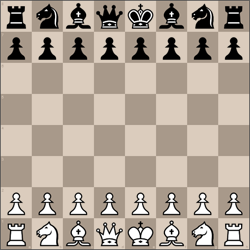< Prev Index Next >
 Chess 07 Feb 1915, Sun The Courier-Journal (Louisville, Kentucky) Newspapers.com
Chess 07 Feb 1915, Sun The Courier-Journal (Louisville, Kentucky) Newspapers.com
OVER THE CHESS BOARD
French Championship Won By M. A. Goetz Just Before the War—One of His Victories.
By Emanuel Lasker.
The French chess championship was decided just before the mobilization for the war was ordered. M. A. Goetz winning with the good score of ten out of a possible eleven games. He did not lose a game, two being drawn. Following is one of his victories.
Alphonse Goetz (white) vs. Amedee Gibaud (black)
Ruy Lopez: Open, Motzko Attack
Submitted to chessgames.com on 04/27/2025
1. e4 e5 2. Nf3 Nc6 3. Bb5 a6 4. Ba4 Nf6 5. O-O Nxe4 6. d4 b5 7. Bb3 d5 8. dxe5 Be6 9. c3 Bc5
Prior to the Petrograd tournament opinions regarding the relative merit of this move and B-K2 were about equally divided, but after that tournament B-K2 was preferred. The game between Lasker and Tarrasch was continued as follows 9. ..., B-K2; 10. QN-Q2, Castles; 11. R-K, N-B4; 12. B-B2, P-Q5; and Black was in a good position.
10. Qd3
Leads to interesting complications, but involves a trap, and its value is doubtful.
10. …Bb6 11. Be3 Nc5 12. Bxc5 Bxc5 13. a4 b4 14. Nbd2 O-O 15. Rae1 Re8 16. Nd4 Nxd4
Almost forced, as it would have been dangerous to leave the white knight in its dominating position at Q4.
17. cxd4 Bf8
B-N3 was the alternative, black having to choose between withdrawing his bishop to KB square, where it would defend the king against the threatened attack by P-B4, in which case his queen’s bishop’s pawn would be left weak; or of playing it to N3, where it would be of no assistance in defending the king’s side.
18. f4 g6 19. Nf3 Bh6
Loss of time. The bishop must return later to B square to guard the weak point at QB4. P-QB4 getting rid of the weak queen’s bishop’s pawn, would have been better, although, after the exchange of pawns, the queen’s pawn would have been isolated and open to attack.
20. Qe3 a5 21. h3
Preparing the attack by the advance of the king’s side pawns.
21. … Rc8 22. Rc1 Bf8 23. Kh2 Qd7 24. g4 c5
A desperate attempt to relieve his cramped position and dispose of the weakness of his queen’s bishop’s file by the temporary sacrifice of a pawn, but it leads only to further disaster. P-QB3, followed by R-B2, would have permitted him to hold out longer. He could not play 24. … P-KB4, because of PxP e.p., RxP; 26. N-K5 (threatening PxB), B-KB4; 27. Q-KB3 with a winning position for White.
25. dxc5 Qa7 26. Qd3
Threatening P-KB5 and also to retain the queen’s bishop’s pawn by advancing it to B6.
26. … Rxc5 27. Rxc5 Bxc5 28. f5 gxf5 29. gxf5 Bc8 30. Bxd5 Ba6 31. Bc4 Bxc4 32. Qxc4 Qc7
R-QB would have been better, as White could not then have replied with 33. R-QB, because of 33. ... B-N8ch; 34. RxBch, QxRch; 35. KxQ RxQ; but White had other good moves at his disposal, and being a pawn ahead with the better position would, no doubt, have won just the same.
33. Rc1 Rc8 34. Qh4 Qd7 35. Qg4+ Kf8 36. f6 Qxg4 37. hxg4 Rc7 38. b3 Ke8 39. Ng5 h6 40. Ne4
Probably overlooking his opponent’s clever reply.
40. … Bd4 41. Nd6+ Kd8 42. Rxc7 Bxe5+ 43. Kg2 Kxc7 44. Nxf7 Bxf6 45. Nxh6
An instructive end game now ensues.
45. …Kc6 46. Kf3 Kd5 47. Nf5 Bg5 48. Ke2 Bf4
Not 48. ... K-K5; because of 49. N-Q6ch, K-B5; 50. N-K5, and both black pawns fall.
49. Kd3 Bc7 50. Ne3+ Ke5 51. Kc4 Ke4 52. Nd5 Bd8 53. Kc5 Kd3 54. Kb5 Kd4
If 54. ... K-B7, White wins easily by sacrificing his knight for the two pawns.
55. Nxb4 axb4 56. a5 Be7 57. a6 Bc5 58. g5 1-0























